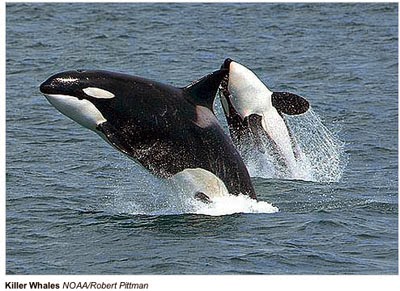The Gentle Killer: Orcinus Orca
(Southern Resident Killer Whales)
Nicole Firenze
http://marinebio.org/species.asp?id=84
Ecology
"Orca" "blackfish" "killer" "grampus" and "swordfish" are all names given to this iconic animal. The Orcinus Orca are a part of the dolphin family, delphinidae, and are the largest dolphins. Despite their intimidating size, killer whales are extremely family oriented, caring and social animals. Killer Whales are known for their black and white color pattern and identified by their black dorsal region and white ventral region. They are a monotypic species although they have some variances in coloring, morphology, and ecology. Being the largest dolphin in the world, the Orcinus orca is at the top of the food chain. As a top predator they eat many marine organisms including fish, squid, mammal species but they mainly prefer salmon. Whatever they choose to eat, it must be in great quantity for male killer whales consume 193,000 to 287,000 kcal per day. Large species, such as Orcinus Orca, are extremely vulnerable to environmental changes and populations can suffer
greatly when neglected.
http://www.sanctuarysimon.org/regional_images/site_build/special_spp_killer_main.jpg
To view killer whales traveling in pods view: https://www.youtube.com/watch?v=-7paFqJ3ieQ
Geographic and Population Changes
Killer whales occur in all oceans but most commonly found in high latitude coastal waters. It is thought that killer whale movement is far ranging but there is a lack of research and evidence to prove this. However, we do know that the killer whale can tolerate a wide range of water environments. The Summer Core Area in Haro Strait and waters around the San Juan Islands, Puget Sound and the Strait of San Juan de Fuca are three designated areas as critical habitat for the species to recover. The killer whale population is divided into three forms: resident, transient, and offshore. They overlap in geography but have great differences in genetics. Populations break into pods and clans in which they socialize, mate, and forage. Pods can intermingle and overlap in geographic ranges creating communities. Southern Residents live primarily around the west coast of Canada, Washington, Oregon, and Northern California.
http://www.fisheries.noaa.gov/pr/pdfs/rangemaps/killerwhale.pdf
http://www.ptmsc.org/images/Science/OrcaProj_images/resident_transient/map%20_TobiMcIntyre.png
The population has gone through many times of growth and decline. The graph below from the Recovery Plan shows the instability in number of whales from 1960 to 2007
 |
| (From the Recovery Plan) |
Listing (Date and Type)
Orcinus orca was listed as an endangered species under the Endangered Species Act on November 18, 2005.
Cause of listing and main threats to its continued existence
The cause of the listing as an endangered species was the declining population of the Southern Resident killer whale. The population decreased about 20% between 1996 and 2001 but researchers still do not know what the exact cause of that decline was. Threats to the population include prey availability, contaminants, pollution, effects from vessels, sound demographics, small population size, vulnerability to oil spills. It is unknown which threat caused the population decline and which will play the largest role in helping recover the population.
http://images6.fanpop.com/image/photos/35700000/Orca-orca-the-killer-whale-35737428-1600-1000.jpg
Recovery Plan
Physical or biological features necessary for the conservation of these whales include water quality, available and sufficient prey species and passage conditions for travel, foraging, and resting. Goals of the recovery plan are to help the population grow and remain stable so that they may be removed from the Endangered list and eventually delisted from the Endangered Species Act. Killer whales will be down-listed to a threatened species when they achieve a population growth of 2.3 percent per year for 14 years while continuing to remove threats to the species. The main goal of delisting is planned to occur in 28 years if the population is able to sustain 2.3 percent population growth. The estimated total cost of the recovery plan is 49,540,000 dollars and requires cooperation of the West coast up to British Columbia. The recovery plan includes restoring salmon, clean up contaminated areas, decrease and monitor pollutants and contaminants going into water that are harmful to the whales, improve guidelines for vessels in killer whale protected areas, prevent oil spills and find ways to better react to them. In addition there are goals to spread public awareness and education, improve reporting sightings of killer whales, improve rescues to help injured and dead whales, study injuries and deaths more to identify major threats, coordinate with Canadian agencies and Federal and State partners, and lastly to continue and expand research.
Work Cited
"Killer Whale (Orcinus Orca)." :: NOAA Fisheries. N.p., n.d. Web. 12 Mar. 2015.
"Orcas (Killer Whales), Orcinus Orca." MarineBio.org. N.p., n.d. Web. 13 Mar. 2015.





No comments:
Post a Comment